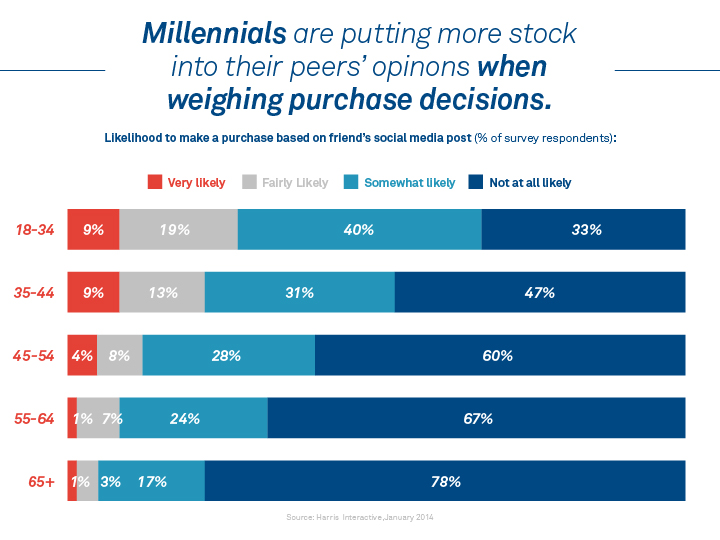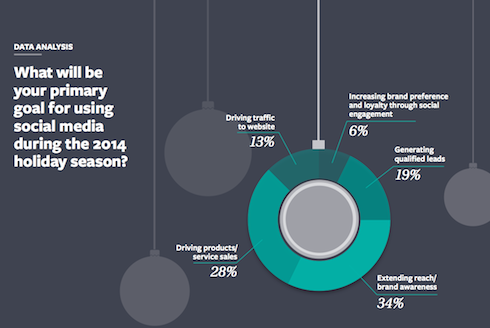By David Howell - September 30th, 2014
Choosing which social media networks should gain more of your corporation’s marketing spend is now of paramount importance to deliver high levels of engagement and loyalty.
With the Christmas season coming up, corporations will need to think carefully about how social media fits into their overall marketing strategy. Social media is now clearly a major component within all marketing teams, but measuring the ROI, understanding the core groups of consumers, and evolving social media as a marketing channel are still challenges many corporations still struggle with.
According to the latest figures from eMarketer the total UK ad spend on social media will increase in the last quarter of 2014, with Facebook dominating. Indeed, Facebook is so central it will take 10% of the total digital ad spend across the UK. Digital as expenditure is also on an upward trajectory with estimates stating that by 2016, social media networks will account for 15% of the total ad spend. This is a significant shift, and illustrates how corporations and their brand communications continue to embrace social media.
A CMO Survey from Duke University does however, highlight the issues that marketers face when measuring the effectiveness of the social media campaigns they develop. Professor Christine Moorman, Duke University Fuqua School of Business said: “Given we see sizable spending increases together with limited growth in human capital, companies are likely spending their budgets on technology and infrastructure to support social media -- payoffs that should help companies reach customers more effectively and measure their activities with greater precision.” Budgets varied from less than $25m pa (33.6 per cent) to $1-$2.5bn (9.2 per cent), while 34 of those surveyed controlled marketing budgets of over $10bn.
Understanding who their customer are was also highlighted in the Duke University report, and the high level of anxiety when analysing the available social media data, with privacy being a particular concern. “The privacy results have remained consistent since we first asked this question of marketers,” Moorman continued. “It is important for companies to strike a bargain with their customers. If companies can promise more value to customers in return for collection and use of their data, many customers would gladly participate in this exchange. However, this exchange needs to be transparent and based on trust.”
Consumer profiling
At the heart of any successful social media marketing campaign will always be a clear understanding of the target audience. With Big Data principles now well understood, corporations have little excuse when it comes to profiling their target consumers.
One of the most coveted consumer sectors is the millennials. They have massive spending power that is increasingly being influenced by social media. Corporations have tried various marketing methods to reach this group – many of which have leveraged social media. New research from ShareThis reveals that the millennials are twice as likely to make a purchase of a product or service they have shared.
ShareThis says: “Millennials are highly active, influential, cross-device, channel-agnostic sharers. They share more often, and in turn are more likely to be listened to: millennials users are 3.6 times more likely to share content on social networks, and 2.3 times more likely to click back on content shared by their peers. Moreover, they’ve put to use all of the social channels available to them, and have gracefully settled into the multi-screen, cross-device ecosystem of the modern web.
“It’s a commonly accepted notion that this generation is harder to reach, less receptive to advertising, immune to brand decisions,” the report continued. “To certain degree this is true; surveys conducted by Harris Interactive have found that among the many ad formats that were most likely to be ignored by millennials, digital ads were on top. Evidently, a generation that was born into digital was also thrust into the roaring din of advertising.
“By now, though, we know that the Web is far more than another blank canvas on which to place banner ads, especially if we’re trying to engage with an audience with a built-in talent for spotting your intentions from a mile away. For millennials, interactivity and discussion are far more likely to influence purchase decisions than viewability.”
Millennials are highly active, highly influential, multi-channel, cross-platform sharers. What defines this audience isn’t so much when they were born, but the space that the social web occupies in their lives. Pay close attention to their sharing habits and broaden your reach across social channels and devices.
Their digital profile is an extension of their personal profile. Millennials may be reluctant to self-identify on surveys and questionnaires, but their sharing behaviours online reflect their personal interests to a greater degree. Reach them via key passion points, like family and politics, to engage with them more deeply.
Millennials are a more nuanced demographic than we make them out to be. What typifies them as an audience are the many different ways in which they use the social web to project their lives. Don’t throw the kitchen sink; appeal to their life stages and backgrounds rather than their age groups.
Corporations then that want more bang for their buck with their social media marketing simply need to pay more attention to their customers, and their behaviour across each social media network. Where your marketing spend should be directed then becomes a much clearer path.
And how does your corporations persuade its customers to buy? In their book ‘The small BIG: small changes that spark big influence’ the authors offer a number of ‘psychological nudges’ that your corporation can put into practice now:
- Nudge 1: Nudge people to buy/pay using social proof by telling them about the large number of people who have already bought/paid (UK tax authority HMRC used this to boost payment from late-payers from 57% to 86%).
- Nudge 2: Nudge people to adopt a new product (go against the crowd/convention) using negative competitor-user imagery by pairing crowd/convention behaviour with unpopular/undesirable people/groups.
- Nudge 3: Nudge people to buy by talking about the costs or benefits of deviating from the norm (e.g. if buying is the/their norm, then highlight the costs of not buying (deviating from norm), but if buying is not the norm, highlight the benefits of buying (deviating from the norm).
- Nudge 4: Nudge people to buy a new product (and thereby violate a social norm) using active social proof by showing others actively buying (or in the case of pro-social behaviour, if the social norm is to drop litter, show others picking up litter).
- Nudge 5: Nudge people to pay attention by using their first name; first name cues our attention (cocktail party phenomenon – from the background din of chatter, you notice when someone uses your name).
- Nudge 6: Nudge people towards buying by focusing both on how they have similar traits to other buyers and that they are dissimilar to non-buyers (focus on uncommon commonalities).
- Nudge 7: Nudge people to spot marketing opportunities by pairing them with a fresh set of eyes (familiarity leads to opportunity-blindness).
- Nudge 8: Nudge people to buy by first securing an active (and public) pre-sales commitment (e.g. sign up for information – for instance missed appointments dropped by 25% when patients filled in an appointment card themselves).
- Nudge 9: Nudge people indirectly in small steps, by first encouraging them to engage (publicly if possible) in a low-cost activity consistent with buying, and then using further cues to trigger purchase.
- Nudge 10: Nudge people to buy ‘sinful/guilty’ products by providing them with a way to offset the guilt and ‘licence’ the behaviour (e.g. placing recycling bins in a room will encourage wasteful behaviour).
ShareThis concludes: “For millennials, the path to purchase is a collaborative experience; according to Harris Interactive, roughly 70% of millennials are at least “somewhat likely” to base a product purchase on their friends’ social media posts. In turn, these users will share and propagate their own opinions across their social networks; we found that millennials were, on average, 3.6 times more likely to share product reviews and recommendations. The ramifications are compelling, especially when considering that positive shared recommendations have the power to increase purchase intent by 9.5%, on average.”
The holidays are coming
With the Christmas season fast approaching, this is an ideal opportunity for all corporations to put into action what they have learned about how their customers behave across their social media networks. Offerpop have looked closely at the US consumer market to discover the marketing trends all corporations should pay attention to. Christmas is a microcosm of marketing that can reveal masses of data – but more importantly – practical insights into when social media marketing spending should be directed.
Offerpop conclude: “Social media has reached a new level of maturity, becoming a vital tool in the marketer’s arsenal. If you need proof, just take a look at the staggering number of consumers currently engaging on social. 1.32 billion monthly active users on Facebook. 271 million on Twitter and 200 million on Instagram.
“And each of these networks is growing year over year. Social media has become a mission critical element for a successful holiday marketing campaign. By developing a strong social media strategy, leveraging user-generated content, and driving social commerce, you can make this holiday season your most profitable one yet. The study found that 67% of marketers polled will be increasing their social spend this holiday season, with only 4% indicating they would decrease their spend.”
And 73% marketers polled identified Instagram as the breakout social network of 2014, with Vine and Snapchat making up the remaining 27%. And considering only 17% of US adults are using Instagram, it is easy to understand why there is such a large spending disparity between Instagram and Facebook (Microsoft Social Listening). However, as Instagram continues to grow its audience, attract older users and launch their own social commerce product to compete with Twitter and Facebook, expect marketers to ramp up investment in 2015.
Also, the research by Offerpop is revealing, as it also considers the new up and coming social media networks such as SnapChat, Swarm and Wanelo and concludes that: “As the social media marketing space matures, marketers are no longer running after the new and untested simply to be the first to market. In fact, 48% of marketers do not plan on investing in any of these emerging players this holiday season.
“But that doesn’t mean marketers aren’t taking note. With 20% showing interest in investing in Swarm, and 16% in Snapchat, marketers are beginning to test the waters with these new networks in order to evaluate where they fit in their overall marketing plan. Instead, marketers are evaluating new networks to ensure they will add legitimate business value to the brand.”
Corporations must then choose the social media networks they support with marketing spending based on detailed profiling of their customer bases. Understanding the motivations to buy behind these groups will deliver the granular insight corporations need to make their marketing campaigns highly effective and profitable.
[Image Source: Rosaura Ocho.]
Next Reads
June 2015, New York
With over 50 expert speakers (including 15 CMOs and CCOs) from the world’s most social brands, and 300+ of your corporate peers in attendance, #CSMNY offers unrivaled learning, networking and benchmarking opportunities. It is truly THE social media event of year.
Brochure Programme

